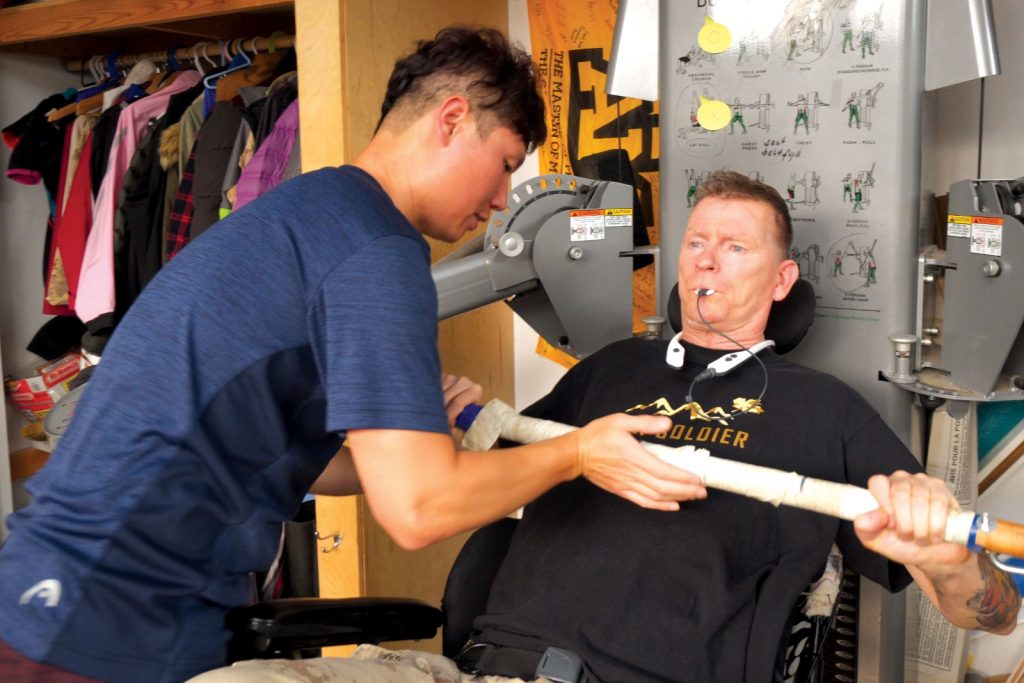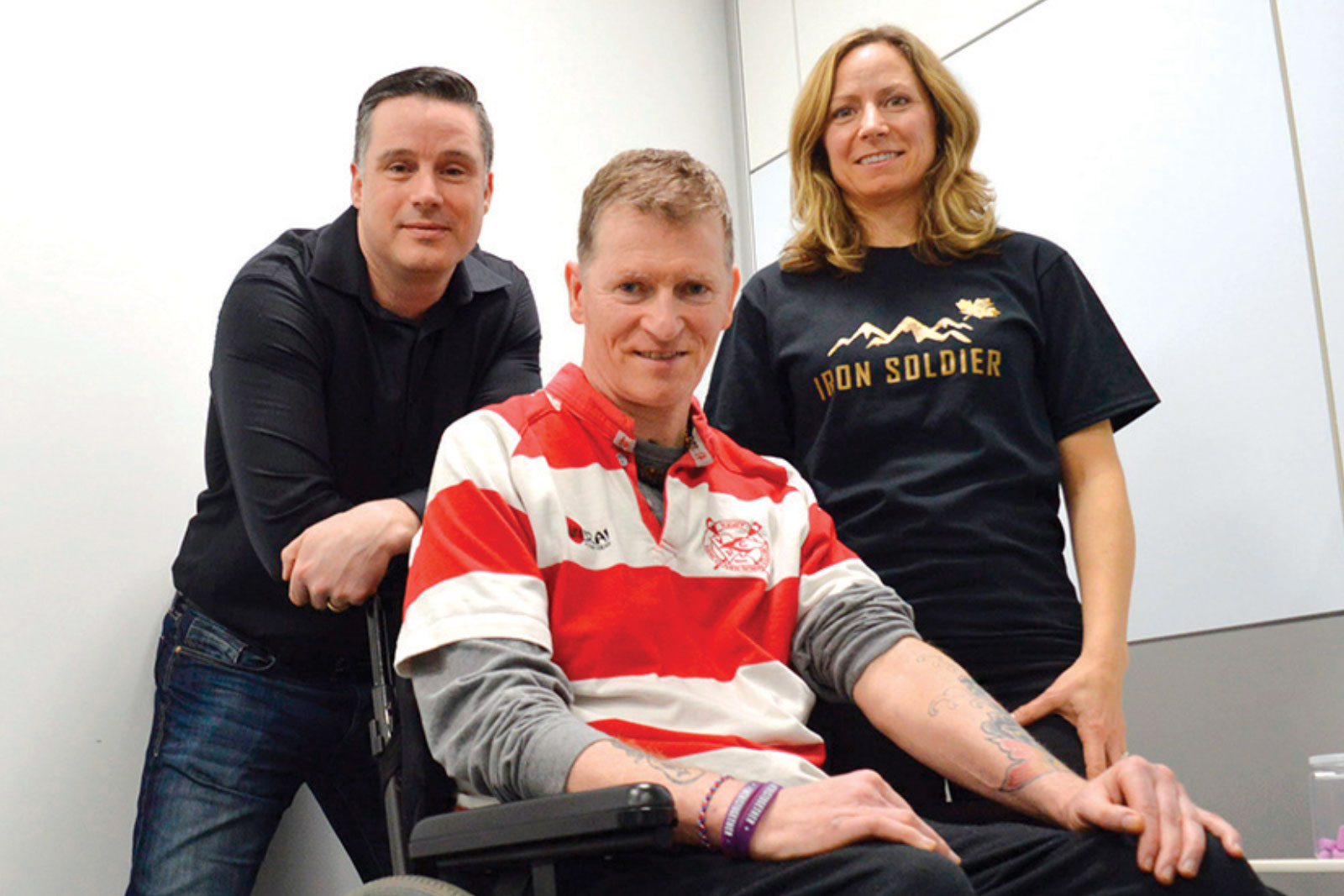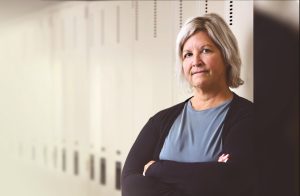Canadian veteran Capt. Trevor Greene pushes the limits of physical, cognitive and PTSD recovery from Afghanistan axe attack.
A scientific study led by the Centre for Neurology Studies at HealthTech Connex and a research team from Simon Fraser University (SFU) has reported its latest breakthroughs on Project Iron Soldier. A peer reviewed study published in Frontiers of Human Neuroscience, highlights Captain (retired) Trevor Greene’s physical, cognitive and PTSD improvements that continue to disrupt conventional limits in recovery.
Breakthrough science Led by neuroscientist Dr. Ryan D’Arcy, the study involves tracking Capt. Greene’s neuroplasticity as he rewires his brain using the latest and most advanced brain technologies. Just a month before the global pandemic was declared, Greene and Dr. D’Arcy co-founder of Health Tech Connex, recounted their remarkable progress and showcased their mission to lead scientific breakthroughs in neuroplasticity in a TEDx talk. Particularly relevant in a time when COVID -19 is increasingly being linked to brain health, progress made offers hope and optimism.
Injured in combat In 2006 Capt. Greene survived a severe, open traumatic brain injury during his tour of duty. Greene spent years in various therapies and rehabilitation but in 2009 he started tracking his progress with Dr. D’Arcy. In 2015, the BC and Yukon Command of the Royal Canadian Legion helped outfit him with a robotic exoskeleton, which he uses to continue re-learning to walk.
Called Project Iron Soldier, Dr. D’Arcy’s work with Greene has been inspiration to develop the Legion Veterans Village, a $312 million Centre of Excellence for PTSD, mental health and rehabilitation. The facility, which is currently under construction in Surrey, British Columbia, is dedicated to veterans and first responders.
Breaking the plateau Capt. Greene and the Project Iron Soldier research team continued intensive daily rehabilitation, but when Greene had an extended plateau in progress they decide to break through and launch an intensive 14-week study using the Portable Neuromodulation Stimulator (or PoNS™) in combination with physical therapy. The objective: to safely stimulate novel neuroplasticity and track brain vital sign improvements using the NeuroCatch® Platform.
PoNS is a neuromodulation technology that sends a series of small electrical impulses to the brain by stimulating the tongue (known as translingual neurostimulation). NeuroCatch is a rapid objective measure of cognitive brain function. A number of published clinical studies demonstrate applications for both the PoNS and NeuroCatch for brain injury. However, according to the team, the current case study with Project Iron Soldier highlights a significant real-world application that pushes the limits of recovery in physical abilities, cognitive processing, and PTSD symptoms.
Pushing new frontiers Our team has been leading clinical research to develop and validate advanced brain technologies like these for a few years and have seen incredible results,” says Dr. D’Arcy, who is also an SFU professor. “When Trevor experienced a plateau in his rehabilitation, we tried intensive conventional treatment to no avail. It was only after combining stimulation with the PoNS device and his rehab therapy that we could break through and demonstrate significant clinical improvements.”
Trevor’s amazing progress is, “no doubt pushing the frontiers of medical science by overcoming perceived limits of brain recovery,” says Dr. Shaun Fickling, the study’s lead author who completed his PhD at Simon Fraser University. “These brain imaging results provide valuable insight into the importance of unleashing the power of neuroplasticity to inspire countless people impacted by brain and mental health conditions.”
Neuro-technology breakthroughs have considerable impacts to inspire and push beyond conventional limits in neurological and mental health recovery. For veterans and first responders, who remain resilient in the face of frequent exposure to trauma, this research and science underpins the inspiration for the newly developed Legion Veterans Village.

Study results The newly published results demonstrate that PoNS neurostimulation, paired with intensive rehabilitation, may stimulate neuroplasticity to overcome an extended recovery plateau. Main findings:
• Capt. Greene showed significant gains in clinical outcome measures for physical therapy. It is noteworthy that these improvements occurred more than 14 years after the axe attack. Capt. Greene and his wife Debbie Greene also reported notable and lasting improvements in cognition and PTSD symptoms.
• Greene showed significant brain vital sign improvements in cognitive function, particularly in auditory sensation (as measured by the N100 response), basic attention (as measured by P300 response), and cognitive processing (as measured by N400 response).
The team was fascinated with the results. “While the focus was physical therapy, NeuroCatch scans detected cognitive improvements and Trevor and his wife, Debbie, reported greatly reduced PTSD symptoms,” claims D’Arcy. “My favorite line in our published paper was when Debbie closed the study by saying, ‘I got my superman back.’”
The Centre for Neurology Studies is a boutique clinical research site that administers clinical trials and consulting services, specializing in neuroscience. www.centreforneurologystudies.com.
References available on request.














